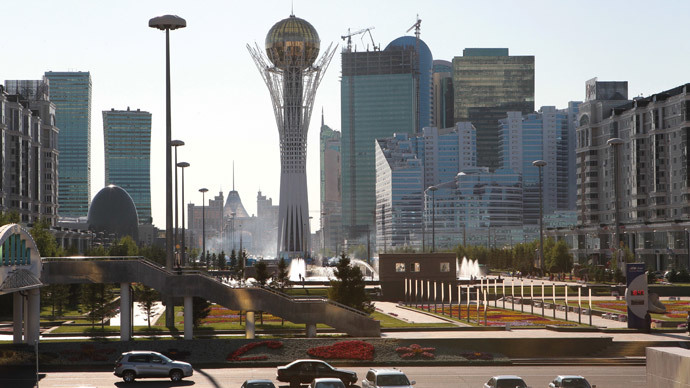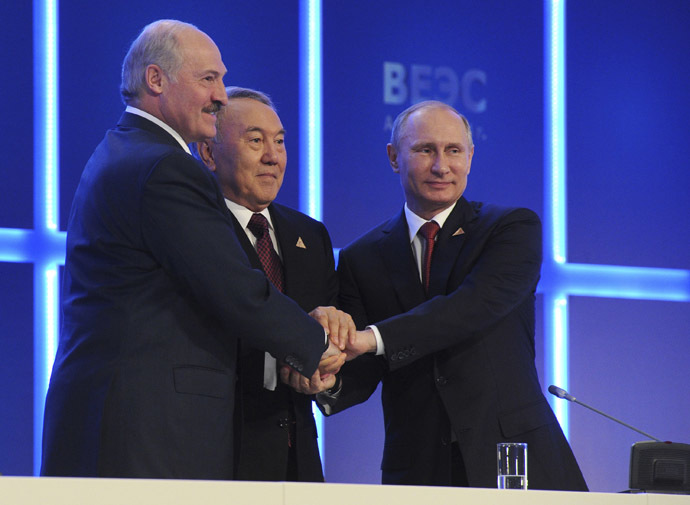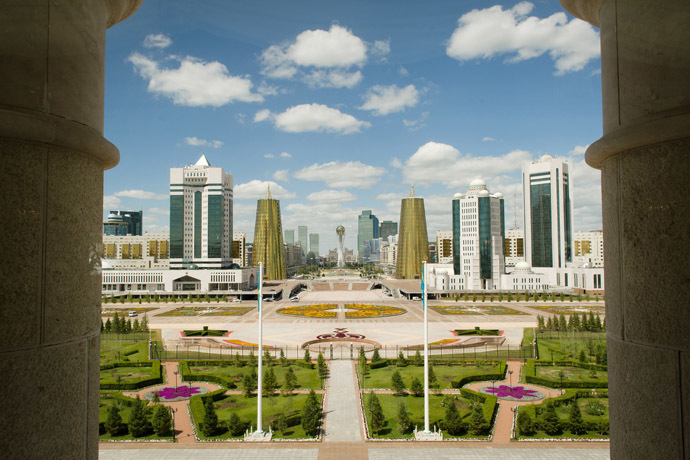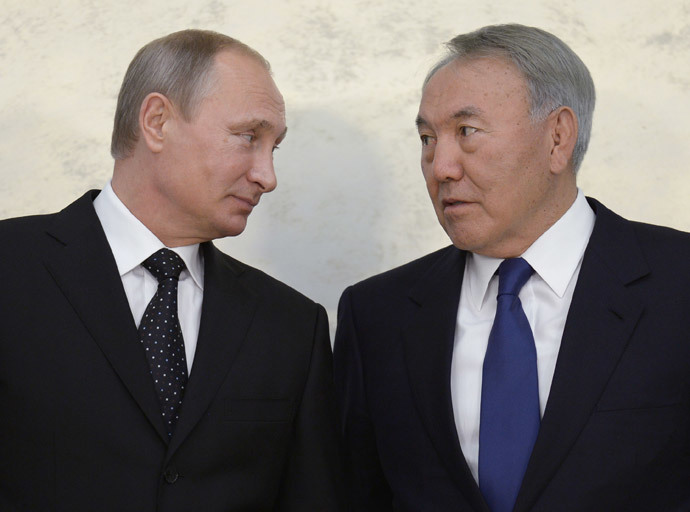Eurasian Economic Union: Despite Western myths, a remarkably sensible project

The recent ratification of the treaty on the Eurasian Economic Union by the Belarusian parliament removed the last doubts about the start of this ambitious project, which involves a market of 170 mn people and $2.7 trillion of combined domestic product.
Since the treaty has already been ratified by the Russian parliament, there is little doubt that Kazakhstan’s lawmakers will soon follow suit. After all, the treaty was signed by presidents Vladimir Putin, Aleksandr Lukashenko and Nursultan Nazarbayev in Kazakhstan’s capital, Astana, in May, and it would be preposterous for the hosts to drag their feet.
So, what kind of countries will this Union bring together? Is it indeed just a “veiled” attempt at reconstructing the Soviet Union, as Hillary Clinton put it when this project – Vladimir Putin’s brainchild – was first announced in 2012? And who will it unite – the rich and hopeful or “throwbacks to the Soviet past” who can’t get rid of their dependence on Russia, as the mainstream Western media writes?

Let us look at the facts. There is a sure way of telling which of the post-Soviet countries are more or less wealthy and which are not – you just have to look at the migrant workers coming to Moscow to do non-prestigious jobs. There are millions of those arriving from the countries which are considered by the West to be “European hopefuls” and which signed association agreements with the EU – Ukrainians and Moldovans in the first place. But there are very few from Belarus and there are literally none from Kazakhstan. Why? The answer is simple: the average monthly salary in Ukraine has been about $350 in 2014, while in Kazakhstan it is almost twice as much – $689. When people get decent salaries, they prefer to make money at home. So much for the European “hopefuls” and the Eurasian “throwbacks.” Let us take a closer look at one of the bulwark countries of the Eurasian Economic Union, Kazakhstan.
Kazakhstan: unlikely success
Kazakhstan is a country with a 17 million-strong, multiethnic population where Slavic-speaking Russians and Turkic-speaking Kazakhs form the largest two groups. It is Russia’s neighbor, rich in oil and gas, and also has a very good strategic position, linking China, Muslim Central Asia, the European part of Russia, Caucasus and Iran (which are right behind the oil-rich Caspian Sea). But historically, Kazakhstan was much poorer and less developed educationally than Ukraine or Moldova. It was also considered not “globalized” enough, being far removed from European capitals and being a part of the politically volatile Central Asian region, with its coups, revolutions and fears of the Afghan Islamist influence.
However, modern Kazakhstan, with its ATM machines in every village, futurist architecture, 70 percent of the population being active Internet users and 28th place in the global index on e-government, does not look like an isolated provincial country at all. Its proximity to Russia was viewed by its president, Nursultan Nazarbayev, not as an impediment, but rather as an advantage.
At the recent Caspian summit in Astrakhan, Russia’s Vladimir Putin and Kazakhstan’s Nursultan Nazarbayev were in 100 percent agreement on the future legal status of the Caspian Sea. This year Kazakhstan is on track for 4 percent economic growth (The European Bank for the Reconstruction and Development expected Kazakhstan to make 5.5. percent, but the forecast was downgraded in May because of the EU’s sanctions against Russia, which also adversely affect Kazakhstan).

The other thorny truth for the Washington-based “nation-builders” is that Kazakhstan, with its independent multi-vector foreign policy, is now showing better results than some of the faithful students of the US in the post-Soviet space. The outflow of the Russian population, visible in the 1990s, has dwindled in recent years, and now the demographic situation in Kazakhstan is much better than in the Baltic EU member states, which saw a dramatic fall in childbirth and a continuing labor migration to the EU countries. Kazakhstan is much more peaceful than the Western darlings of Ukraine and Georgia, with their civil wars. Kazakhstan did not have coups and West-applauded revolutions, with people “protecting their vote” with Molotov cocktails and the “activist” habit of throwing the undesired officials into trash containers. Kazakhstan has had the same president since 1991. But somehow, Eurasian Kazakhstan took the 28th place in the United Nations’ e-government development index EGDI (“European” Ukraine did not make it even into the top 30 in Europe). Having an opportunity to have your driver’s license delivered in two hours, to check your tax situation or medical data at any time of night or day online – all of these small bits of “e-democracy” are probably worth the inconvenience of NOT seeing the constant rotation of Mrs. Tymoshenko’s and Mr. Poroshenko’s faces on your TV, don’t you think?
Reasons for progress: not doing the wrong things
What was the difference that made Kazakhstan, formerly not the best-developed Central Asian territory of the Soviet Union, more successful than the European Ukraine? Well, Kazakhstan simply did not do several self-defeating things the nationalists regimes of Viktor Yushchenko and Petro Poroshenko did in Ukraine. Kazakhstan did not declare its Russian-speaking population “an obstacle on our road to Europe” (an expression of the virulently pro-Maidan Ukrainskaya Pravda). Also, Kazakhstan was not as obsessed with the EU as Ukraine, preferring to take the best from both Asia and Europe.
At the recent UN Global e-Government Forum 2014, held in Astana, Kazakh officials did not hide the fact that they tried to model the national e-government system after the South Korean one. But if we bear in mind that South Korea has taken the 1st place in the UN’s e-government rating three times in a row, the idea to copy THIS Asia might not seem all that ill-conceived.
The South Korean officials, speaking at the Astana gathering, returned the favor, saying that estimates show Kazakhstan to have the best developed e-government network among the land-locked countries, which generally tend to be homes to the world’s “bottom billion” of poor people.

Wise twinnings
In less than two decades, Astana has managed to twin itself with Moscow, Kiev and Tbilisi at the same time. If we add Beijing and Warsaw (and Gdansk) to this only seemingly contradictory collection of twin cities, the “multi-vector” picture of Kazakhstan’s foreign policy orientation becomes complete. This foreign policy mix is pretty well suited by Astana’s futuristic architectural skyline – where even the British architect Lord Foster is giving his creations the likeness of nomads’ yurts and where throwbacks to Soviet pseudo-Gothic towers are neighbors to the 21st century eggs and torts – the ones which would make London’s City look like a collection of Georgian country mansions.
Unlike the US, Kazakhstan did not applaud the revolutions in Ukraine and in neighboring Kyrgyzstan, where the violent change of government in 2010 led to hundreds of deaths. Kazakhstan only tried to help, harboring refugees and providing diplomatic mediation.
For some reason, the economically prosperous Kazakhstan managed to avoid both the “Russian irredentism” (for which in the first post-Soviet years there seemed to be a lot more reasons than in Slavic Ukraine) and the constant arguments over gas supplies to and from Russia. At the same time, Kazakhstan managed to stay sovereign and independent, developing Kazakh language as the national one – but not to the detriment of Russian, which remained the language of interethnic communication and learning.
Conclusions for outsiders
So, these facts might explain why the Eurasian Union is expected to be joined by Armenia and Kyrgyzstan before the end of the year. Despite all the difficulties, being in the same group with Kazakhstan looks definitely a better perspective than being in the same group with Ukraine.
Dmitry Babich for RT
Dmitry Babich is a political analyst for Voice of Russia radio
station
The statements, views and opinions expressed in this column are solely those of the author and do not necessarily represent those of RT.
The statements, views and opinions expressed in this column are solely those of the author and do not necessarily represent those of RT.












